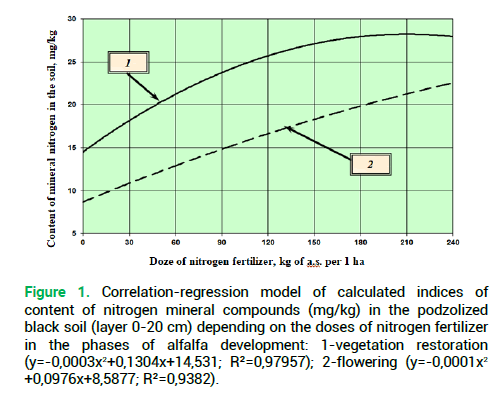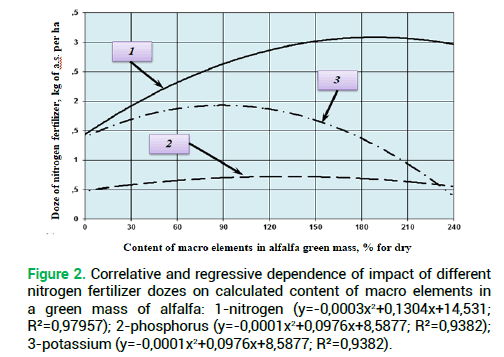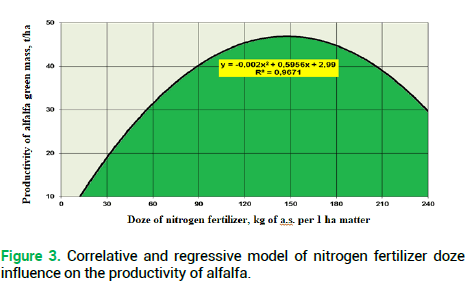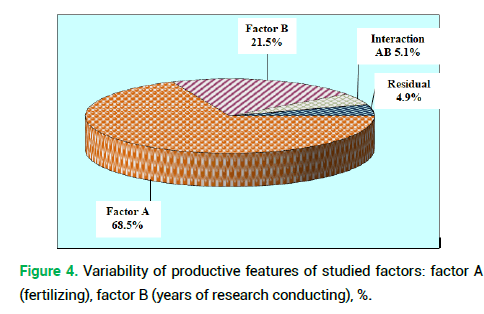Research Article - Modern Phytomorphology ( 2020) Volume 14, Issue 1
Regularities of sowing alfalfa productivity formation while using different types of nitrogen fertilizers in cultivation technology
Kokovikhin SV1, Kovalenko VP1, Slepchenko AA2, Tonkha OL3, Kovalenko NO3, Butenko AO4* and Ushkarenko VO52Kyiv National University Named After Taras Shevchenko, Volodymyrska Str. 64/13, Kyiv, 01601, Ukraine
3National University of Life and Environmental Sciences of Ukraine, Kyiv, 03041, Ukraine
4Sumy National Agrarian University, Gerasim Kondratyev Str. 160, Sumy, 40021, Ukraine
5Kherson State Agrarian University, Stretenskaya str., 23, 73006, Kherson, Ukraine
Butenko AO, Sumy National Agrarian University, Gerasim Kondratyev Str. 160, Sumy, 40021, Ukraine, Tel: 380501945713, Email: andb201727@ukr.net
Received: 30-Nov-2019 Accepted: 27-Dec-2019 Published: 03-Jan-2020, DOI: 10.5281/zenodo.4453889
Abstract
The provision of alfalfa with the nutrients throughout the whole growing period is an important factor in influencing the yield. We researched the content of mineral nitrogen in the typical black soil and the productivity of green mass of sowing alfalfa. As a result of research, we have found that the use of CAM in comparison with ammonium nitre in the norm of 90 kg/ha increased the total nitrogen content in the green mass of alfalfa by 0.17%. The mineral compounds of nitrogen in the podzolized black soil were 36%-87% higher compared with the variant without fertilizers. Increasing the rate of phosphorus from 60 to 90 kg/ha increased the content of total phosphorus in sowing alfalfa by 0.09%-0.11% and potassium by 0.19%-0.23% respectively. When using the CAM rate N180 on the P60K60 background the highest yield of green alfalfa (43.5 t/ha) was obtained, the difference comparing to N110P90K120 did not exceed 5%. Correlative and regressive modeling allowed to establish that the content of mineral nitrogen is minimal (15 mg/ha) in the phase of restoration of alfalfa vegetation in the control variant and further was noted its rapid increase to 26-28 mg/kg on the background of nitrogen fertilizer application in doses N150-N180. In the flowering phase, a significant (19.4%-39.8%) decrease of calculated indices of the content of nitrogen mineral compounds was noted, but there appeared a steady dynamics of growth of these indices in the variants with high doses of nitrogen fertilizers. The optimal doses of fertilizer application have been determined at the level from 120 to 145 kg per 1 ha which provides yields of green mass at the level of 45-47 t/ha. The variability of productive features affirms the maximum impact on alfalfa productivity at mineral nutrition background-68.5%, the weather conditions account for 21.5%, the interaction of these factors takes 5.1%, and the influence of unaccounted factors is at the level of 4.9%.
blog
blog
blog
blog
blog
blog
blog
blog
blog
blog
blog
blog
blog
blog
blog
blog
blog
blog
blog
blog
blog
blog
blog
blog
blog
blog
blog
blog
blog
blog
blog
blog
blog
blog
blog
blog
blog
blog
blog
blog
blog
blog
blog
blog
blog
blog
blog
blog
blog
blog
Keywords
Fertilizer rate, carbamide-ammonia mixture (CAM), sowing alfalfa, the content of total phosphorus, nitrogen, potassium, mineral compounds of nitrogen, correlation-regression modeling, the variability of productive features
Introduction
High productivity formation of fodder sowing alfalfa requires the development of a scientifically substantiated fertilizer system and is an irreplaceable part of its cultivation technologies. Application of phosphorus and potassium fertilizers is sufficiently substantiated in scientific publications (Babych 1994; Petrychenko, 2010; Senyk 2019; Radchenko et al. 2018). Concerning the expediency of introducing nitrogen fertilizers for legumes, fertilizing strategies, the opinion of scientists is not undivided. It is explained by the ability of legumes, thanks to their biological characteristics, to fix nitrogen from the air with the help of tuber bacteria. A prominent scientist D. M. Pryanishnikov notes that about 30% of nitrogen is absorbed by the root system of legumes from soil (Marchuk 2000; Medvedev 2004; Tonkha, Dzyazko 2014; Tonkha et al. 2018). Alfalfa provides itself with nitrogen by 80-90% due to symbiotic nitrogen fixation, but in the initial stages of organogenesis, it is necessary to apply 40 kg/ha of nitrogen or to carry out pre-sowing treatment of seeds with biological preparations (Marchuk 2000; Medvedev 2004). Researches of scientists have shown that the application of nitrogen fertilizers in the additional fertilizing in spring or after each mowing of perennial legume herbs causes inhibition of tuber bacteria vital functions, and the lack of nitrogen during these periods leads to the yield decrease of green mass (Petrychenko 2010; Kovtun 2012; Tanchik 2009). Research of K. P. Kovtun, 2012 found that fodder productivity of alfalfa was directly dependent on the application of nitrogen fertilizer doses, but not more than 120 kg/ha.
The aim of the research was to evaluate the content of nitrogen mineral compounds in the podzolized black soil, the content of total nitrogen, phosphorus and potassium in the green mass of alfalfa and the productivity under different norms and types of nitrogen fertilizers while growing sowing alfalfa (Tsyhanskyi et al. 2019; Kovtun at al. 2016).
Materials and Methods
The studies were conducted in the field experiment of LLC “Khmilnitske” at Khmelnytskyi district, Vinnytsia region in the period of 2010-2015 on the podzolized, coarse and medium-loamy black soil in the forest, which was laid in 2005. The effect of fertilizer variants was studied: 1. without fertilizers (control); 2. P60K60+N60aa; 3. P90κ120+N90 aa; 4. P60κ60+N60 κAC; 5. P90κ120+N90κAC; 6. P90κ120+N90κAC+N10 κAC+N10 κAC; 7. P60K60+N60κAC+N60 κAC+N60.
The acreage of the sowing area was 260 m2, the acreage of the account area-50 m2. To achieve this goal and fulfill the objectives of the research program we conducted accounting, observation, and analysis according to conventional methods: contents of mineral nitrogenaccording to SSTU 4729: 2007, moisture content by mass was determined by gravimetric method (SSTU ISO 11465-2001). Statistical analysis of experimental data was performed according to the methods of B. A. Dospekhov with the usage of Microsoft Excel mathematical apparatus; the typicalness of weather conditions was determined according to the methods of Yu. P. Manjko by the index of deviation coefficient Ki. The dry matter content was determined in the plant samples by thermogravimetric method (STST 29268-89); total nitrogen after ashing was determined (Ginsburg method) photocolorimetrically with Nessler reagent; total phosphorus after ashing was determined photocolorimetrically by the Denizh method in modification of Levitsky (STST 26657-85); total potassium after ashing with was determined with the help of flame photometer. Accounting of biological productivity of alfalfa was fulfilled manually in triple repetition.
Hydrothermal conditions are of great importance for the growth and development of sowing alfalfa. The average annual temperature only in 2010 and 2015 varied significantly from the long-term average one, but there were significant deviations (Ki) of average monthly air temperatures from the norm during the period of active growth and development of crops. Thus, in March 2010, a critical decrease was observed, in May 2011 and 2014-a decrease, and in 2013-an increase. The critical temperature increase occurred from May to July of 2012. So, in order to neutralize the negative effects of weather conditions and obtain high yields of sowing alfalfa, it is necessary to create the optimal nutrient regime of soils.
The provision of available nutrients throughout the whole vegetation period, especially during the critical phases of its growth and development, is important for alfalfa. Particularly important are the mineral forms of nitrogen, which directly affect the growth of the vegetative part, many biochemical processes that cause an increase in dry matter content and the yield (Marchuk 2000; Balayev, Kovalchuk, Doroshevych 2011). The content dynamics of nitrogen mineral compounds (mg/kg) in the podzolized black soil (layer 0-20 cm) for different norms and types of nitrogen fertilizers are given in Tab. 1.
| Fertilizing variantsli | Contents of mineral nitrogen, mg/kgli | |
|---|---|---|
| Vegetation renovationli | Floweringli | |
| Without fertilizers (control) | 14.8 | 8.9 |
| P60K60+N60 аа | 20.1 | 12.8 |
| Р90К120+N90 аа | 23.3 | 14.8 |
| Р60К60+N60 КАM | 23.3 | 16.9 |
| Р90К120+N90 КАM | 24.6 | 17.2 |
| Р90К120+N90КАM+N10 КАM+N10 КАM | 24.6 | 18.4 |
| P60K60+N60КАM+N60КАM+N60КАM | 27.8 | 22.4 |
| LSD05 | 1.1 | 0.98 |
Table 1. The content dynamics of nitrogen mineral compounds (mg/kg) in podzolized black soil (0-20 cm layer) for different norms and types of nitrogen fertilizers, the average for 2010-2015. Fertilizing variants Contents
According to the results of experimental data analysis, it was proved that increasing the rate of nitrogen both in the application of CAM and ammonium nitre contributed to the increase of the content of mineral compounds of nitrogen in the podzolized black soil by 36%-87%. The use of CAM, comparing with ammonium nitre, increased the norm content 60 kg/ha of mineral nitrogen by 3.2 mg/ kg, and 90 kg/ha by 1.3 mg/kg respectively. The highest rates in the podzolized black soil were obtained with the introduction of N180KAM against the background of P60K60 and they amounted to 22,4-27,8 mg/kg of soil.
According to the results of a correlation-regression analysis, it was found that the content of mineral compounds of nitrogen varied greatly depending on the background of nitrogen nutrition on the experimental areas with alfalfa (Fig. 1).

Figure 1. Correlation-regression model of calculated indices of content of nitrogen mineral compounds (mg/kg) in the podzolized black soil (layer 0-20 cm) depending on the doses of nitrogen fertilizer in the phases of alfalfa development: 1-vegetation restoration (y=-0,0003x2+0,1304x+14,531; R2=0,97957); 2-flowering (y=-0,0001x2 +0,0976x+8,5877; R2=0,9382).
It was determined that in the phase of restoration of alfalfa vegetation in the control variant, the content of mineral nitrogen was at the level of 15 mg/ha with the further rapid increase to 26-28 mg/kg of soil during increasing the background of nitrogen nutrition in variants with doses application of this nutrition macroelement to 150-180 kg of a.s. per 1 ha of area. Further increase of nitrogen doses to 210-240 kg of a.s. per 1 ha did not contribute to the content increase of nitrogen mineral compounds in the soil.
In the flowering phase was noted a significant (19.4- 39.8%) decrease in the calculated indices of the content of nitrogen mineral compounds in the 0-20 cm soil layer. However, were revealed the regularities of steady increase in the studied indices of correlation-regression model with the level rise of nitrogen fertilizer doses within the range from 8 mg/kg (in the variant without application of this nutrition element) to 23 mg/kg (with application on the areas with theoretical introduction of N240). It should be noted that elaborated models have a determination coefficient (R2) close to one indicating a high degree of correlation between the studied indicators.
The quantity and quality of crop yield is the final criterion for the intensity of metabolism. Their nature and direction depend on biological characteristics, the technology of growing and, in particular, on the conditions of nutrition. Management of plant vital activity processes in the optimum range is possible only through a comprehensive study of the influence of nutrients on their growth and development. Levels of nutrient content in separate organs of plants indicate the optimal concentrations of macro-and microelements in their tissues in certain stages of growth and development. They provide optimal cell metabolism, so they can serve as optimization indicators of plant mineral nutrition.
According to our research, we can conclude that the highest nitrogen content in the leaves of alfalfa was provided by cumulative use in the norm N180КАM on the background of P60K60-3.20% for a dry matter which is 1.78% higher than the variant without fertilizers (Tab. 2).
| Variant of fertilizing | N | P2O5 | K2O |
|---|---|---|---|
| Without fertilizers (control) | 1.42 | 0.28 | 1.20 |
| P60K60+N60 аа | 2.35 | 0.38 | 1.47 |
| Р90К120+N90 аа | 2.65 | 0.49 | 1.70 |
| Р60К60+N60 КАM | 2.48 | 0.40 | 1.49 |
| Р90К120+N90 КАM | 2.82 | 0.50 | 1.69 |
| Р90К120+N90КАM+N10 КАM+N10 КАM | 2.92 | 0.50 | 1.69 |
| P60K60+N60КАM+N60КАM+N60КАM | 3.20 | 0.39 | 1.50 |
| LSD05 | 0.14 | 0.09 | 0.16 |
Table 2 : Content of total nitrogen, phosphorus and potassium (% for the dry matter) in the green mass of alfalfa according to different norms and types of nitrogen fertilizers, the average for 2010-2015.
Comparing the usage of CAM with ammonium nitre showed that no significant increase in nitrogen content was obtained at the rate of 60 kg/ha, but 90 kg/ ha increased the corresponding indicators by 0.17%. Increasing the rate of phosphorus from 60 to 90 kg/ha increased the content of total phosphorus in the green mass of alfalfa by 0.09-0.11% and potassium respectively by 0.19%-0.23%.
Production of high quality and ecologically safe forage including fodder protein is an urgent task of the fodder production industry. These issues are closely related to the formation and implementation of state policy in the environmental and agrarian spheres and the provision of national security of Ukraine as a whole. Looking at Ukraine’s intention to integrate with the European Union and bring its legislation into line with the Acquis communautaire, it is reasonable to mention EU acts concerning the usage, in particular, promoters of growth and other hazardous substances in fodder. A number of normative acts are devoted to the regulation of animal fodder composition in the EU. In particular, Directives 2002/32/EU of the European Parliament and the Council from the 7th of May, 2002 is in force in this area. Regulation of the European Parliament and the Council No 767/2009 from 13th of July, 2009 on the placing at the market and the usage of fodders. It introduces changes into Regulation of the Parliament and the Council No 1831/2003 and repeals Council Directive 79/373/EEC, Commission Directive 80/511/EEC, Council Directives 82/471/EEC, 83/228/EEC, 93/74/EEC, 93/113/ EC and 96/25/EC and Commission Decision 2004/217/EC (About Reliability and Hygiene of Fodders, 2018). In this regard, the Law of Ukraine “About Safety and Hygiene of Fodders” from the 21st of December, 2017, which aims to regulate relations between state authorities and people engaged in the production and/or circulation of fodders (operators of fodder market) concerning guaranteeing the safety of fodders including at the stages of their production, circulation, and usage.
Conducted indices modeling of total nitrogen, phosphorus and potassium content in the green mass of alfalfa depending on the influence of different doses of nitrogen fertilizers allowed to establish significant fluctuations between separate studied parameters (Fig. 2).

Figure 2.Correlative and regressive dependence of impact of different nitrogen fertilizer dozes on calculated content of macro elements in a green mass of alfalfa: 1-nitrogen (y=-0,0003x2+0,1304x+14,531; R2=0,97957); 2-phosphorus (y=-0,0001x2+0,0976x+8,5877; R2=0,9382); 3-potassium (y=-0,0001x2+0,0976x+8,5877; R2=0,9382).
It should be noted that the calculated content of total nitrogen in the green mass of alfalfa increased most (from 1.5-2.7% for the dry matter) with increasing the background of nitrogen nutrition in variants with doses up to 120 kg a.d. per 1 ha. Further, the growth of total nitrogen slowed down, and after the doses of nitrogen fertilizers in the range of 185-190 kg d. a./ha-appeared negative reaction with a decrease in the studied index.
Regarding calculated indices of phosphorus was recorded a weak reaction to the dynamics of calculated values content of this element on the background of increasing nitrogen fertilizer doses during alfalfa cultivation. A slight increase of content P2O5 to 0.6%-0.7% was observed on the background of increasing nitrogen doses in the range from N90 to N140, with a further decrease of this modeled index.
Theoretical indices of potassium content in the green mass of alfalfa were characterized initially by slow growth, and further by a sudden decrease in the proportion to increase of nitrogen nutrition background at the experimental areas. The highest rates were observed when applying nitrogen fertilizers in doses from 70 to 100 kg of a.s./ha-1.6-1.9% for dry matter after the dose of N180-indices decreased to 1.3% with further fall to 0.4% for dry matter.
The productivity of alfalfa green mass is given in Tab. 3. Comparative analysis showed a significant increase in yields while using CAM compared to ammonium nitre only at the rate of 60 kg/ha, which was 2.4 t/ha. Usage of different fertilizer variants increased productivity by 2.0- 7.0 t/ha compared with control.
| No. | Variant | Productivity, t/ha | ± before control, t/ha |
|---|---|---|---|
| 1 | Without fertilizers (control) | 36.5 | - |
| 2 | P60K60+N60 аа | 38.5 | 2.0 |
| 3 | Р90К120+N90 аа | 42.0 | 5.5 |
| 4 | Р60К60+N60 КАM | 40.9 | 4.4 |
| 5 | Р90К120+N90 КАM | 42.3 | 5.8 |
| 6 | Р90К120+N90КАM+N10 КАM+N10 КАM | 42.6 | 6.1 |
| 7 | P60K60+N60КАM+N60КАM+N60КАM | 43.5 | 7.0 |
| LSD05 | 2.3 | - |
Table 3 : Influence of carbamide-ammonia mixture on alfalfa productivity, t/ha (average for years 2010-2015).
The highest productivity of alfalfa green mass was obtained while using the norm N180 on the background P60K60, which was 43.5 t/ha. The first spring application is advisable to carry out in the absence of snow cover before restoration of alfalfa vegetation in March with a dose of 90 liters per 1 ha, when the air temperature does not exceed 10°C, CAM-32 dilution is not required.
Modeling of the theoretical yield level of alfalfa green mass depending on the background of nitrogen nutrition made it possible to determine clearly the optimal range of fertilizer doses to obtain the highest plant productivity of the studied crop (Fig. 3).

Figure 3. Correlative and regressive model of nitrogen fertilizer doze influence on the productivity of alfalfa.
It is established that nitrogen fertilizers with doses from 120 to 145 kg of a.s. are required to obtain the yield of green mass within 45-47 t/ha. The further increase in doses of nitrogen fertilizers causes a decrease in alfalfa productivity. In addition, the excessively high background of nitrogen nutrition is not economically reasonable and has an environmental risk for agro phytocoenosis.
Dispersion processing of experimental data allowed to establish that mineral fertilizers which have 68.5% in the total alfalfa specific productivity weigh in the experimental areas makes the greatest contribution to the crop formation (Fig. 4).

Figure 4. Variability of productive features of studied factors: factor А (fertilizing), factor В (years of research conducting), %.
The variability of weather conditions caused an impact on the productivity of the studied crop at the level of 21.5%, and the interaction of factors A and B was 5.1%. The residual impact of unaccounted factors was 4.9%.
Conclusion
While using CAM in the norm N180 on the background of P60K60 the highest yield of alfalfa green mass (43.5 t/ha) was obtained, the difference comparing with N110P90K120 did not exceed 5%. A comparison of CAM usage with ammonium nitre showed that no significant increase in nitrogen content was obtained at the rate of 60 kg/ ha and 90 kg/ha increased the corresponding indicators by 0.17%. Increasing the rate of phosphorus from 60 to 90 kg/ha increased the content of total phosphorus in the green mass of alfalfa by 0.09-0.11% and potassium respectively by 0.19-0.23%. Correlative and regressive modeling allowed to establish that in restoration phase of alfalfa vegetation in the control variant the content of mineral nitrogen is minimal (15 mg/ha), and further its rapid increase is noted to 26-28 mg/kg of soil on the background of nitrogen fertilizer application in doses N150-N180. In the flowering phase, a significant (by 19.4- 39.8%) decrease in calculated content indices of nitrogen mineral compounds was noted, but there was a steady growth dynamics of this indicator in variants with high doses of nitrogen fertilizers. Optimal doses of fertilizer application from 120 to 145 kg a.s. per 1 ha which provides yields of green mass at the level of 45-47 t/ha have been determined. The variability of productive features indicates the maximum impact of mineral nutrition background-68.5% and the weather conditions-21.5% on the productivity of alfalfa. The interaction of these factors was 5.1% and the influence of unaccounted factors-4.9%.
References
- Babych A.O. 1994. Research methods of fodder production. Vinnytsya. 87. https://scholar.google.com.ua/citations?user=ZGEiFysAAAAJandhl=uk
- Senyk I.I. 2019. Feeding productivity of alfalfa and cereal mixture depending on fertilizing system and method of li-sowing processing for seeds of leguminous component. Bull Agrarian Sci. 31-37. https://doi.org/10.31073/agrovisnyk201902-04
- Tonkha O.L., Dzyazko Y.S. 2014. Soils and Plant Roots. Structural properties of porous materials and powders used in different fields of science and technology. Engine Material and Proc. 221-249. https://doi.org/10.1007/978-1-4471-6377-0_11
- Tanchik S.P. 2009. Efficiency of farming systems in Ukraine. Bull Agrarian Sci. 12: 5-11. https://scholar.google.com.ua/citations?user=1vj_Y8MAAAAJandhl=ru#d=gs_md_cita-dandu=%2Fcitations%3Fview_op%3Dview_citation%26hl%3Dru%26user%3D1vj_Y8MAAAAJ%26citation_for_view%3D1vj_Y8MAAAAJ%3AIjCSPb-OGe4C%26tzom%3D-180
- Tonkha O.L., Sychevskyi S.O., Pikovskaya O.V, Kovalenko V.P. 2018. Modern approach in farming based on estimation of soil properties variability. 12th Int Con Monitor Geol Procand Ecol Cond Envir. 68-74. DOI: 10.3997/2214-4609.201803199
- Kovtun K.P. 2012. Impact of foliar application and inoculation on formation of specific composition of goat’s-eastern in single crop sowings and in combined ones: Fodders and fodder production. Int Thematic Collec-Vinnytsya. 72: 130-134. http://www.irbis-nbuv.gov.ua/cgi-bin/irbis_nbuv/cgiirbis_64.exe?I21DBN=LINKandP21DBN=UJRNandZ21ID=andS21REF=10andS21CNR=20andS21STN=1andS21FMT=ASP_metaandC21COM=Sand2_S21P03=FILA=and2_S21STR=kik_2012_72_26
- Tsyhanskyi V.I., Didur I.M., Tsyhanska O.I., Malynka L.V., Butenko A.O., Masik I.M., Klochkova T.I. 2019. Effect of the cultivation technology elements on the activation of plant microbe symbiosis and the nitrogen transformation processes in alfalfa agrocoenoses. Modern Phytomorphol. 13: 30-34. https://doi.org/10.5281/zenodo.20190107
- Kovtun K.P., Veklenko Yu.A., Kopaihorodska H.O. 2016. Chemical composition and feed quality of degenerate meadow grass stands under different ways of their improvement in the conditions of the Right-bank Forest Steppe. Vinnytsia. 204-209. http://www.irbis-nbuv.gov.ua/cgi-bin/irbis_nbuv/cgiirbis_64.exe?I21DBN=LINKandP21DBN=UJRNandZ21ID=andS21REF=10andS21CNR=20andS21STN=1andS21FMT=ASP_metaandC21COM=Sand2_S21P03=FILA=and2_S21STR=kik_2016_82_37
- Marchuk I.U. 2000. Fertilizers-basis of yield increase and soil fertility. I.U. Marchuk Propo. 2. https://propozitsiya.com/
- Medvedev S.S. 2004. Physiology of plants. St. Petersburg: publishing house St. Petersburg. 48-54. https://www.twirpx.com/file/1102469/
- Petrychenko V.F. 2010. Alfalfa with new features for crop pastures. Agrarian Sci. 96. ISBN 978-966-540-302-9.
- About reliability and hygiene of fodders: Law of Ukraine from the 21st of December, 2017. 2018. Official Bull Ukraine. 9: 332. https://base.spinform.ru/show_doc.fwx/show_doc.fwx?rgn=103904
- Petrichenko V.F. 2010. Relevant problems of fodder production in Ukraine. Herald Agrarian Sci. 10: 18-21. http://nbuv.gov.ua/UJRN/vaan_2010_10_6
- Radchenko M.V., Butenko A.O., Glupak Z.I. 2018. Effect of fertilizer system and efficiency of growth regulator on buckwheat productivity in the conditions of the northeastern forest-steppe of Ukraine. Ukrainian J Ecol. 8: 89-94. http://dx.doi.org/10.15421/2018_314
- Balayev A.D., Kovalchuk O.P., Doroshevych N.F. 2011. Content and stock changes of humus in gray forest soils in use of various seed crops as green fertilizers. Forage and Fodder Produc. 70: 106-110. file:///C:/Users/User/Downloads/kik_2011_70_20.pdf